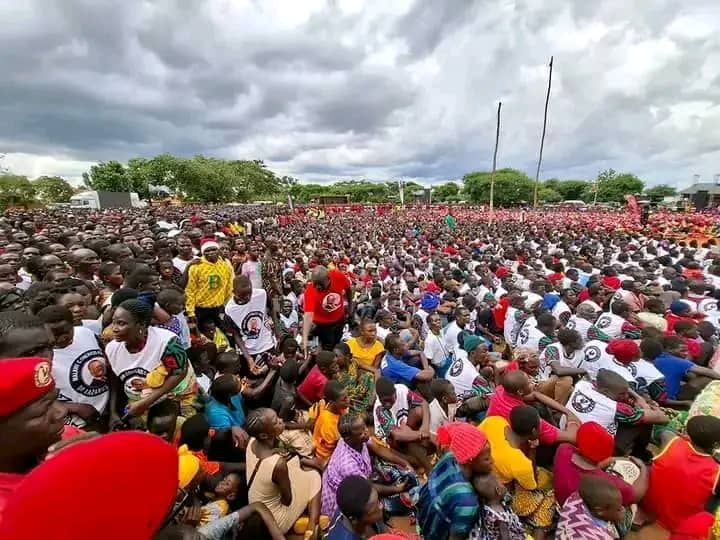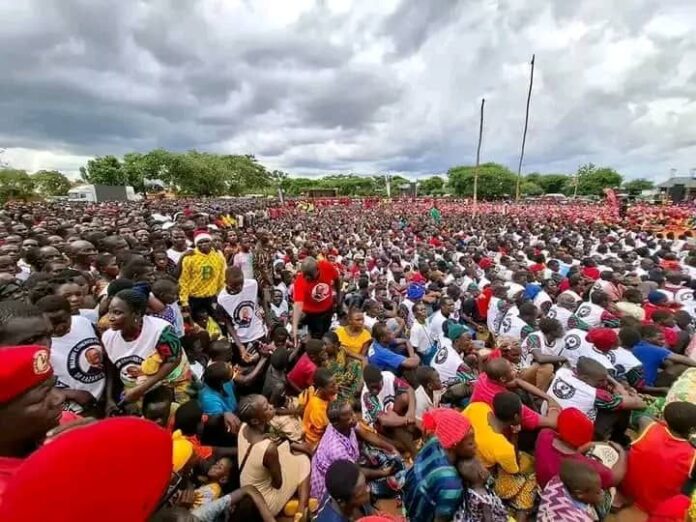By Burnett Munthali
The reported attendance of millions of Malawians at a Malawi Congress Party (MCP) rally in Kasiya, Lilongwe, is a significant political event that carries deep implications for the country’s political landscape. This massive turnout reflects various aspects of MCP’s influence, public sentiment, and the upcoming 2025 elections. While such large gatherings can be a demonstration of political dominance, they also raise important questions about voter loyalty, governance expectations, and the state of Malawi’s democracy.
Firstly, the large turnout in Kasiya demonstrates MCP’s ability to mobilize supporters on a massive scale. Political rallies serve as a visual representation of a party’s strength, and the sheer number of attendees sends a strong message to both supporters and opponents that MCP remains a formidable force. The event showcased the party’s deep-rooted influence, particularly in the Central Region, which has historically been an MCP stronghold.

MCP’s strong mobilization structures, particularly at the grassroots level, played a key role in making the rally successful. The presence of youth, women, and regional leaders at such events further cements the party’s ability to organize effectively. This ability to gather large crowds is crucial as it builds momentum ahead of elections and maintains public engagement between campaign cycles.
Secondly, the attendance of millions at the Kasiya rally suggests that many Malawians still align with MCP and President Lazarus Chakwera’s leadership. Despite economic challenges, governance concerns, and opposition criticism, the massive turnout signals that a significant portion of the population remains supportive of the ruling party. The rally provided an opportunity for MCP leaders to reinforce their policies, outline their vision, and reassure citizens of their commitment to development.
However, while such rallies indicate public interest, they also serve as a reminder of the expectations that Malawians have from the government. If MCP fails to deliver on its promises, the same crowds could turn into critics, as public opinion in politics is highly dynamic.
Thirdly, the rally’s massive attendance has a psychological effect on opposition parties, particularly the Democratic Progressive Party (DPP) and the United Transformation Movement (UTM), both of which are working to strengthen their political bases ahead of the 2025 elections. A gathering of this magnitude creates a narrative that MCP remains the most dominant political force in Malawi.
For opposition parties, this event serves as a wake-up call, urging them to improve their mobilization strategies and ensure that they also command large followings. If the opposition fails to match such numbers, it may struggle to convince undecided voters that MCP’s dominance can be challenged.
Fourthly, Kasiya, like much of the Central Region, has traditionally been an MCP stronghold. The massive turnout in this area could reflect not just party loyalty but also regional politics at play. Many Malawians still vote along regional lines, and the Central Region has consistently supported MCP in previous elections. This suggests that MCP’s grip on the region remains intact, making it a critical base for the party going into the next elections.
However, for MCP to secure national victory in 2025, it must extend this level of support to other regions, particularly the Southern and Northern regions, where the opposition has historically had strongholds. The party must ensure that its policies appeal to a broad range of voters beyond its traditional bases.
Fifthly, one of the most crucial questions following the Kasiya rally is whether such large attendance will translate into votes during the elections. Political rallies in Malawi, like in many African democracies, can sometimes attract large crowds due to factors such as free transport, allowances, and entertainment. It is not always a direct indicator of genuine electoral support.
MCP must be cautious not to assume that these numbers will automatically convert into votes. The real challenge lies in ensuring that supporters turn up on election day, particularly in rural areas where voter turnout can fluctuate. The party must also engage in grassroots voter education to prevent voter apathy and ensure that its supporters are registered and ready to participate in the elections.
Sixthly, the massive turnout at the Kasiya rally highlights another critical aspect—Malawians are deeply engaged in the country’s political processes, largely because politics directly impacts their daily lives. Many who attended the rally likely came with expectations, particularly regarding economic improvements, job creation, and social welfare programs.
MCP must recognize that large turnouts also mean increased public pressure to deliver results. If the government does not address key concerns such as inflation, unemployment, and service delivery, these same crowds could become disillusioned before the next election. The party’s challenge now is to ensure that its policies resonate with the everyday struggles of Malawians.
Seventhly, the Kasiya rally serves as a strong indicator that MCP remains the party to beat in the upcoming elections. However, it also means that the party must work even harder to consolidate its support base, prevent defections, and counter opposition strategies. The turnout suggests that MCP has the organizational capacity to dominate campaigns, but elections are won through votes, not just crowds.
Opposition parties, meanwhile, will be analyzing this event closely, looking for ways to weaken MCP’s influence and capture undecided voters. The months leading up to the elections will determine whether MCP can maintain this momentum or whether voter dissatisfaction with governance issues will erode its support.
In conclusion, the attendance of millions at the MCP rally in Kasiya is a powerful political statement. It signals the party’s strength, its ability to mobilize supporters, and the confidence many Malawians still have in President Chakwera’s leadership. However, while the rally was a success in terms of numbers, the real test will come in 2025 when Malawians cast their votes.
MCP must not take this turnout for granted but must work diligently to address the economic and governance challenges facing the country. Otherwise, as history has shown, large crowds do not always guarantee electoral victory. For now, however, the Kasiya rally serves as a reminder that MCP remains a dominant force in Malawian politics.



